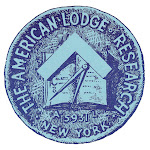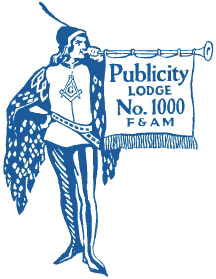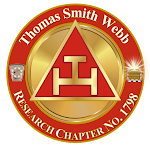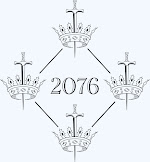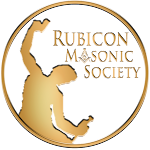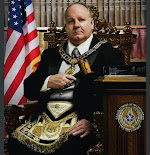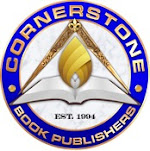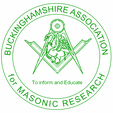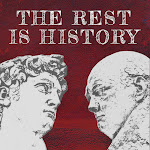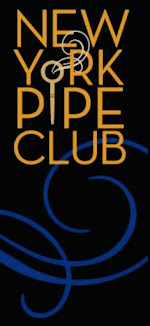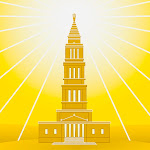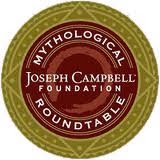
MV Thurman Pace, with the fancy apron, is surrounded by the charter members of Alexandria Council No. 478 of Allied Masonic Degrees, which was set to labor Friday night. It is the third AMD council in New Jersey to receive a warrant from Grand Council this year!
That it shares the name of the
city in Egypt that was home to the ancient world’s largest depository of knowledge,
and the
city in Virginia where the Grand Council of Allied Masonic Degrees meets is fortuitous, as
Alexandria Council No. 478 of the AMD was set to labor Friday night!
M.V. Thurman C. Pace, Jr., Past Sovereign Grand Master of the AMD, convened an emergent communication of Grand Council, appointing Bro. Moises as Marshal, to constitute this new council. With that legality achieved, it was time to install the council’s
officers, which V. Franklin did himself. For the most part, Alexandria’s members are Master Masons at
Nutley Lodge No. 25.


Left: the warrant of Alexandria Council No. 478.
Right: V. Suco reads the document aloud for the edification of the brethren.
The ritual formalities accomplished, it was time for dinner. Our appetites had been primed by a round of – well, not exactly aperitifs, but suitable beverages. (You can rely on us to get that right!) Appetizers of lobster and clam bisques, the best calamari I’ve ever tasted, and the house salad with a nice vinaigrette might have been enough to sustain us, but we weren’t about to take any chances with an occasion so auspicious, and we forged ahead to truly wonderful entrées of beef, fish, and pasta.
While dining, the presentation of papers commenced, and it was a full slate worthy of New Jersey Lodge of Masonic Research and Education itself! Five of the brethren submitted their research work for peer review, with topics varying from history to biography to symbolism to – what I consider to be – the language of the Great Architect of the Universe Himself.
Junior Warden Dave began with a detailed history of the Allied Masonic Degrees, describing the founding of Grand Council and the assimilation of AMD’s many degrees into the large corpus of Masonic rituals worked in the United States. Thurman took the liberty of supplementing Dave’s talk with information on the origins of the AMD in England.
Next, Bro. Moises, of DaVinci Council, discussed the life and times of Daniel Coxe, who is remembered as the first Provincial Grand Master in North America, having received his deputation from the Duke of Norfolk of the Grand Lodge of England in 1730. He was a member of Lodge No. 8, which met at the Devil’s Tavern in London, and went on to receive extensive land grants in what was called West Jersey.
Senior Warden José discussed elements of Craft lodge symbolism. No need to reveal that on-line.
Junior Deacon Hansel, also of the soon-to-be chartered Daniel Coxe Council, gave us a biography of Thomas Smith Webb, the entrepreneurial ritualist of the 18th and 19th centuries who did much of the work toward establishing what we call the York Rite of Freemasonry, within which the AMD is tucked away. He died in 1819; a ritualist to the very end (and beyond!) his remains were buried no fewer than three times over the years. Thurman was present at the dedication of the most recent gravesite monument, an obelisk, in Providence, Rhode Island.
Last, but certainly not least, the new Sovereign Master gave his inaugural presentation, a PowerPoint production illustrating the many fascinating aspects of what is alternately known in
Sacred Geometry as the
Golden Ratio,
Golden Mean, the
Fibonacci Sequence,
Phi, Golden Number,
Divine Proportion, et al.
This is the ratio of 1:1.618, and it figures into so much of nature – from the shape of human DNA to the shells of snails, and the petals of marigolds – that it is not unreasonable to see this
irrational number as a code or language with which God endeavors to communicate with man. When Plato said “God forever geometrizes,” he was talking about this, and it is essential for the thinking Freemason to possess a working understanding of this aspect of geometry. And in the works of man, our art and architecture, this mathematical wonder delivers designs that are the most pleasing to the eye. Whether we realize it or not, when we enjoy the fine arts, and even certain performing arts, we behold the Divine Proportion.

V. Franklin Suco, inaugural Sovereign Master of Alexandria Council, gave a PowerPoint presentation on one of the most important, yet rarely discussed, topics in Freemasonry: the Golden Ratio.
 ▲▼ ▲▼ ▲▼ ▲▼ ▲▼ ▲▼ ▲▼ ▲▼ ▲▼ ▲▼ ▲▼ ▲▼ ▲▼ ▲▼
▲▼ ▲▼ ▲▼ ▲▼ ▲▼ ▲▼ ▲▼ ▲▼ ▲▼ ▲▼ ▲▼ ▲▼ ▲▼ ▲▼
From left: Don, Mark, José, and John are just about to set upon their entrées. The food at Bloomfield Steak and Seafood is exceptional in quality and abundant in flavor.
The building the restaurant calls home is a historic site dating to 1670. The wall behind the brethren here is a buttress attesting to architecture of that era. Originally a private residence, it is one of the oldest buildings in New Jersey.
Bloomfield Steak and Seafood House is an ideal choice of venue for Masonic meetings, not only because it returns us somewhat to our roots in the taverns, but the story of this particular building is amazing, and even involves some notable Freemasons.
Here is how the Township of Bloomfield describes the site in its literature:
Back in the 1600s, they built for longevity. Take for instance the Joseph Davis House, now the Bloomfield Steak & Seafood House, at 409 Franklin Street. The house was built long before the introduction of cement and yet, “it will likely last 1,000 years,” said Ann Hardy, chairperson of the Historic District Review Board. The main walls are two feet thick at base and the cellar walls measure eight to 10 feet thick.
The Davis house is a monument to the early history of Bloomfield, the oldest of the town’s pre-Revolutionary War homes. It is listed on both the state and national historic registers, which do not dictate uses of listed properties. The home is used as a restaurant and no part of it is open for touring, but, “externally, you can still tell it is a very old house,” said Hardy. “It’s one of many houses in Bloomfield that have become different things over time.”
Built by Thomas Davis in 1670, the house was occupied by his descendants until 1903. It has been associated with many historic events:
• During the Revolution, a tunnel in the cellar ran to the foot of Orange Mountain and was used by women and children to escape the British.
• A wounded English soldier was taken in by the Davis family and nursed back to health. To show his appreciation, the soldier built the well that still remains on the property, and hewed the stone wash basin that sits next to the well.
• General George Washington and General Henry Knox stopped at the homestead for directions to Morristown and were entertained for dinner. (Magpie Note: Both were Freemasons.)
• In the late 1700s, when the home was occupied by Deacon Joseph Davis, worship services were regularly held in the house. Otherwise, the closest churches were in Newark or Orange. In 1796, when the First Presbyterian Church on the green was built, Deacon Davis, a founding member, provided, for the sum of eight pounds, the land on which the church still stands.
• The charter of Bloomfield was signed in the house’s “beam ceiling room” by General Joseph Bloomfield in 1796. A group of citizens meeting at the home named the town after Bloomfield, who was a New Jersey governor and Revolutionary War officer.
During the past two centuries, the Davis Homestead has been a farmhouse, hospital, church and restaurant. Only a handful of property transfers has occurred since Revolutionary War times, but what a tale the building tells from its early days!
There had been a Masonic lodge in Bloomfield for generations. Bloomfield Lodge No. 48 was chartered on November 9, 1824. It surrendered its charter exactly six years later, a victim no doubt of the Morgan scandal, but was revived in January of 1856 as No. 40. It no longer exists (it is part of the lineage of Essex Lodge No. 7), but it had been located on the corner of Broad and Liberty streets, practically right across the street from this restaurant.

Bro.
Joseph Bloomfield of Trenton Lodge No. 5, was among the founders of the Grand Lodge of New Jersey, serving as its fifth Grand Master. During the Revolution, he was a major in the
Third New Jersey Regiment. After the war, he served the state as attorney general (1783-92) before resuming military service as a brigadier general of militia. He served as
governor of New Jersey for most of the time between 1801 and 1812, but upon the outbreak of war with Britain again, he served as brigadier general in the U.S. Army.
He returned to government service after that war, representing New Jersey in the U.S. House of Representatives.
▲▼ ▲▼ ▲▼ ▲▼ ▲▼ ▲▼ ▲▼ ▲▼ ▲▼ ▲▼ ▲▼ ▲▼ ▲▼ ▲▼The chartering of Alexandria Council is a wonderful occurrence, but it marks the end of something else that was very special. Since August of 2007, some of these brethren and I met as a private Masonic study group called Quadrivium. Inspired by the mission and the structure of the
Dormer Masonic Study Circle in the United Kingdom, our Quadrivium was an invitational group that would meet in different locations every couple of months to hear the members’ research work and enjoy dinner together. Why Masons must meet in near secrecy to do the work they should be doing in lodge is beyond the maw of my ken.
Anyway, part of me had hoped that this group would evolve eventually into a special lodge that would adopt some of the traits of
European Concept and/or
Traditional Observance lodges. Select membership, excellent ritual, meaningful education in both esoteric and exoteric matters, fine dining, and other aspects that raise the bar to make Masonry a worthy pursuit of serious men.
“It is great to be among friends and brethren in Masonic work,” said V. Suco. “If you don’t know, we have been meeting in private for more than two years. That, plus, Royal Arch, [Cryptic] Council, Commandery, Pennsylvania, Alexandria [Virginia], and New York – we’ve traveled a lot!”
MV Pace echoed that. “It’s great to see a lot of friends here!” he said. “We need a council in this area.”
It was a busy night that exceeded even The Magpie Mason’s endurance, as after the festivities a number of the brethren retired to the bar for drinks. It was a perfect evening of Masonic Light
and fellowship
and dining. The air was nearly electric with what the brethren at
Sons of Liberty call “The Bond,” that hard-to-define essence of group friendship rooted in something that is simultaneously ethereal yet deeply substantial. Or substantially deep.
Yeah, yeah, I
know it’s Freemasonry, but you don’t see it everywhere. I do not sense its presence in lodges that might as well trade their aprons for
funny hats.
▲▼ ▲▼ ▲▼ ▲▼ ▲▼ ▲▼ ▲▼ ▲▼ ▲▼ ▲▼ ▲▼ ▲▼ ▲▼ ▲▼Magpie readers, I point this out to show what it is that confronts the thinking Mason, and the fundamental reason why the “education Mason” feels the need to retreat from his lodge to have an intelligent conversation with like-minded brethren. (That certainly is not the case at Nutley 25. I am speaking generally.)
The following is a mass e-mail circulated last week.
Brethren
Have we lost ourselves in the pursuit of historical research and lost touch with our professed love of our neighbor?...
Let us stop looking within our history and concentrate on DOING UNTO OTHERS! Help someone see the LIGHT OF OUR BROTHERLY LOVE and return those feelings threefold! ACT AND GIVE OF OURSELVES to receive the realization of others that we give of ourselves without thinking of a return. EXCEPT maybe a HUG or a joyful handshake.
History, Books, and the internet are inward thinking and will always be with us. The thought of my old music teacher Mrs. Jones who propounded the idea of G D A E B F = Good Deeds are Ever Beaxring Fruit.
Please do not ask me why so many Masons are so afraid of learning, or why this one believes a man is incapable of reading books and helping others during the same lifetime, but I cite the above to illustrate what thinking Masons are up against. There are those who do not want you wasting time learning about the huge ideas and great men that comprise Masonic history and philosophy when you ought to be limiting yourself to upholding the 1960 model of Masonry as cute, bland service club.
The mantra I repeat to all of the new AMD councils in New Jersey is
Guard the West Gate!












